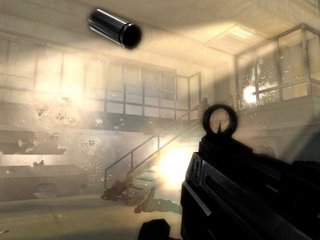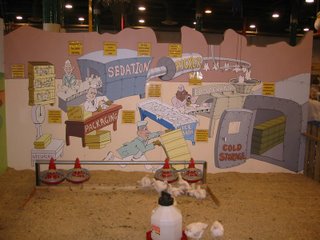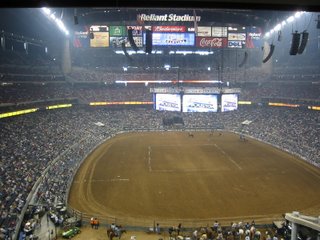Ho-Hum.
Lavie's got the only car (I may get a rental tomorrow) right now. It is a lazy Sunday. Cool. Breezy. Bright. I'm too tired to take a nap. Alvis has decided to re-arrange her bedroom (this is a childhood milestone) so her clothes, gear, stuff, furniture, etc. is strewn across her room and the hallway. But she is making good progress. On top of that, she is 2/3 done with a school project we need to finish up today. I haven't hit the "concerned parent" level yet, but we are getting closer.
One of the very first things I used to do when I got a new system was to slap a firewall on it. Now our systems are sitting behind a hardware router/firewall. But a good firewall doesn't just keep stuff from getting into your computer, it also monitors and limits what gets out. Back when I started, the big test to run on a system was Gibson Research's LeakTest. Still a handy tool. However, the baddies have gotten much more clever at attempting to evade firewalls. A new site I discovered recently is Firewall Leak Tester. This site state's its purpose is to not only provide a multitude of outbound traffic firewall tests, but also to give a comparison between different firewall products. I found it to be very informative. Some user's might not care, but I still find that a firewall is a must, and that outbound monitoring is as important as inbound traffic monitoring. All too often I have caught "legit" applications attempting to "phone-home". How well does your firewall solution stack up?
Another important task when trial-testing software is figuring out where it goes on your system. I wish more vendors would write software that unpacked into a central program folder then used an .ini file for it's settings, instead of heavy registry modifications. Anyway, to find out what a program really does when it installs you need to be able to compare "before and after" lists of what files and registry settings got installed, modified and changed. The program I prefer to use is called Install Watch (from Epsilon Squared). This is a free application that takes a system "snapshot" prior to software installation, then takes another post-installation and shows you the differences. It is wizard based so it is very easy to use. A review here. A second product I have recently seen is What Changed (from Vista Software). It is also free. The interface is very simple and plain but it gets the job done. It is a standalone exe file so no system installation is required. Great to keep handy on a USB stick.
If burning media is your thing, consider adding BurnAtOnce to your bag of tricks. It is free software that supports CD media and (with a little update) DVD media as well. It can even make bootable CD media. Also don't forget the handy Folder2Iso freeware. A standalone .exe file, you arrange a folder (subfolders/contents) and then point this app to it. It will create an ISO format file that you can then burn or use with virtual drive software like Daemon Tools. I find these two applications are very handy when planning out and testing software tool cd's at work. I have saved a ton of $ on bad-cd burns by making test images and testing them virtually.
Lifehacker has a post on how to "Set up a home wireless network." Even though Lavie's laptop has wireless built in, I still am not ready to install a wireless router. This guide does give you a pretty good idea of the steps you will need to take putting one in. Eventually I will probably install one. I have heard good things about this model. Leo Lapore and Steve Gibson gave me the idea of cascading routers on a home network to isolate components. I have my cable modem, next would be the wireless router, and plugged into that would be my current router. That should (theoretically) prevent anyone from accessing the router downstream (were that to happen) but I guess someone could (wirelessly) sniff the traffic from the bottom router coming up the pipes if they cracked the wireless security. Anyway, I like the idea of the convenience of a wireless Internet connection, but still (even with it locked down) I have some concerns. Has anyone actually tried putting home routers in series this way?
It appears a new Ghost in the Shell movie is in production. GITS: Solid State Society.
Additional GIS:SSS linkage from DannyChoo:
GITS:SSS--models and drawings,
GITS:SSS--promotion trailer (video!)
Finally, Lavie is working hard at getting up to speed in her desktop publishing assignment. She is close to getting approval for the purchase of an Adobe design suite. Her employer might also set her up with a second workstation--Apple style! Cool. One of the neat things she uncovered was a site that uses web-magazine publishing software from NXTbook Media. Sample from Bentley.com. Slick!
Anyway, Drawn! had a post about a technical drawing illustrator Kevin Hulsey. His site has some awesome work, but as an added bonus, he has a "students page" corner where he shows some l33t graphic arts techniques in technical illustation. The best part is his two-part step-by-step walk through of a cruise ship cutaway illustration.
I hope you also enjoy the new Blogger picture of us in the top-left column. Lavie thought a family "photo" would be nice--so there it is!
See Ya!
--Claus
Lavie's got the only car (I may get a rental tomorrow) right now. It is a lazy Sunday. Cool. Breezy. Bright. I'm too tired to take a nap. Alvis has decided to re-arrange her bedroom (this is a childhood milestone) so her clothes, gear, stuff, furniture, etc. is strewn across her room and the hallway. But she is making good progress. On top of that, she is 2/3 done with a school project we need to finish up today. I haven't hit the "concerned parent" level yet, but we are getting closer.
One of the very first things I used to do when I got a new system was to slap a firewall on it. Now our systems are sitting behind a hardware router/firewall. But a good firewall doesn't just keep stuff from getting into your computer, it also monitors and limits what gets out. Back when I started, the big test to run on a system was Gibson Research's LeakTest. Still a handy tool. However, the baddies have gotten much more clever at attempting to evade firewalls. A new site I discovered recently is Firewall Leak Tester. This site state's its purpose is to not only provide a multitude of outbound traffic firewall tests, but also to give a comparison between different firewall products. I found it to be very informative. Some user's might not care, but I still find that a firewall is a must, and that outbound monitoring is as important as inbound traffic monitoring. All too often I have caught "legit" applications attempting to "phone-home". How well does your firewall solution stack up?
Another important task when trial-testing software is figuring out where it goes on your system. I wish more vendors would write software that unpacked into a central program folder then used an .ini file for it's settings, instead of heavy registry modifications. Anyway, to find out what a program really does when it installs you need to be able to compare "before and after" lists of what files and registry settings got installed, modified and changed. The program I prefer to use is called Install Watch (from Epsilon Squared). This is a free application that takes a system "snapshot" prior to software installation, then takes another post-installation and shows you the differences. It is wizard based so it is very easy to use. A review here. A second product I have recently seen is What Changed (from Vista Software). It is also free. The interface is very simple and plain but it gets the job done. It is a standalone exe file so no system installation is required. Great to keep handy on a USB stick.
If burning media is your thing, consider adding BurnAtOnce to your bag of tricks. It is free software that supports CD media and (with a little update) DVD media as well. It can even make bootable CD media. Also don't forget the handy Folder2Iso freeware. A standalone .exe file, you arrange a folder (subfolders/contents) and then point this app to it. It will create an ISO format file that you can then burn or use with virtual drive software like Daemon Tools. I find these two applications are very handy when planning out and testing software tool cd's at work. I have saved a ton of $ on bad-cd burns by making test images and testing them virtually.
Lifehacker has a post on how to "Set up a home wireless network." Even though Lavie's laptop has wireless built in, I still am not ready to install a wireless router. This guide does give you a pretty good idea of the steps you will need to take putting one in. Eventually I will probably install one. I have heard good things about this model. Leo Lapore and Steve Gibson gave me the idea of cascading routers on a home network to isolate components. I have my cable modem, next would be the wireless router, and plugged into that would be my current router. That should (theoretically) prevent anyone from accessing the router downstream (were that to happen) but I guess someone could (wirelessly) sniff the traffic from the bottom router coming up the pipes if they cracked the wireless security. Anyway, I like the idea of the convenience of a wireless Internet connection, but still (even with it locked down) I have some concerns. Has anyone actually tried putting home routers in series this way?
It appears a new Ghost in the Shell movie is in production. GITS: Solid State Society.
Additional GIS:SSS linkage from DannyChoo:
GITS:SSS--models and drawings,
GITS:SSS--promotion trailer (video!)
Finally, Lavie is working hard at getting up to speed in her desktop publishing assignment. She is close to getting approval for the purchase of an Adobe design suite. Her employer might also set her up with a second workstation--Apple style! Cool. One of the neat things she uncovered was a site that uses web-magazine publishing software from NXTbook Media. Sample from Bentley.com. Slick!
Anyway, Drawn! had a post about a technical drawing illustrator Kevin Hulsey. His site has some awesome work, but as an added bonus, he has a "students page" corner where he shows some l33t graphic arts techniques in technical illustation. The best part is his two-part step-by-step walk through of a cruise ship cutaway illustration.
I hope you also enjoy the new Blogger picture of us in the top-left column. Lavie thought a family "photo" would be nice--so there it is!
See Ya!
--Claus















